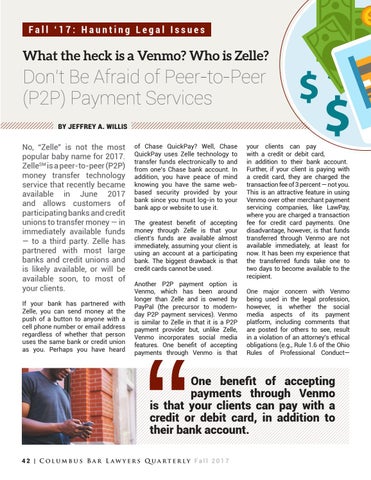Fall ‘17: Haunting Legal Issues
What the heck is a Venmo? Who is Zelle?
Don’t Be Afraid of Peer-to-Peer (P2P) Payment Services by jeffrey a. willis No, “Zelle” is not the most popular baby name for 2017. ZelleSM is a peer-to-peer (P2P) money transfer technology service that recently became available in June 2017 and allows customers of participating banks and credit unions to transfer money — in immediately available funds — to a third party. Zelle has partnered with most large banks and credit unions and is likely available, or will be available soon, to most of your clients. If your bank has partnered with Zelle, you can send money at the push of a button to anyone with a cell phone number or email address regardless of whether that person uses the same bank or credit union as you. Perhaps you have heard
of Chase QuickPay? Well, Chase QuickPay uses Zelle technology to transfer funds electronically to and from one’s Chase bank account. In addition, you have peace of mind knowing you have the same webbased security provided by your bank since you must log-in to your bank app or website to use it. The greatest benefit of accepting money through Zelle is that your client’s funds are available almost immediately, assuming your client is using an account at a participating bank. The biggest drawback is that credit cards cannot be used. Another P2P payment option is Venmo, which has been around longer than Zelle and is owned by PayPal (the precursor to modernday P2P payment services). Venmo is similar to Zelle in that it is a P2P payment provider but, unlike Zelle, Venmo incorporates social media features. One benefit of accepting payments through Venmo is that
your clients can pay with a credit or debit card, in addition to their bank account. Further, if your client is paying with a credit card, they are charged the transaction fee of 3 percent — not you. This is an attractive feature in using Venmo over other merchant payment servicing companies, like LawPay, where you are charged a transaction fee for credit card payments. One disadvantage, however, is that funds transferred through Venmo are not available immediately, at least for now. It has been my experience that the transferred funds take one to two days to become available to the recipient. One major concern with Venmo being used in the legal profession, however, is whether the social media aspects of its payment platform, including comments that are posted for others to see, result in a violation of an attorney’s ethical obligations (e.g., Rule 1.6 of the Ohio Rules of Professional Conduct—
One benefit of accepting payments through Venmo is that your clients can pay with a credit or debit card, in addition to their bank account. 42 | Columbus Bar L aw yers Quarterly Fall 2017
c
